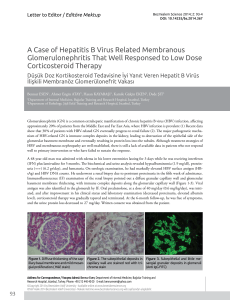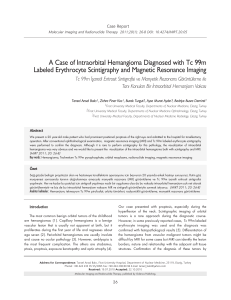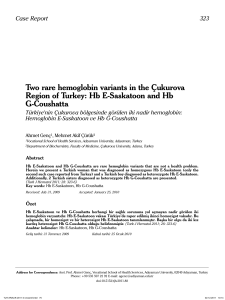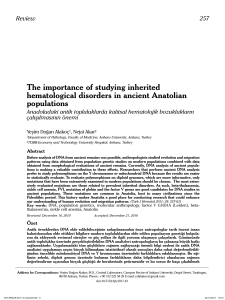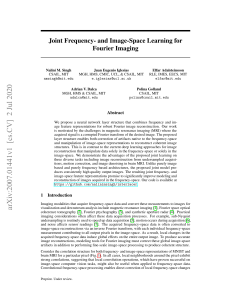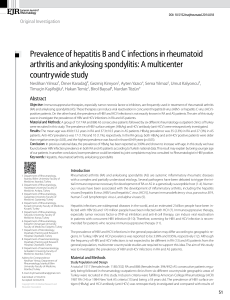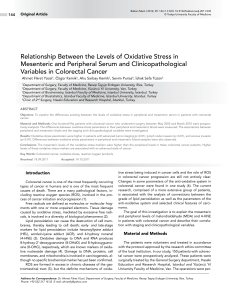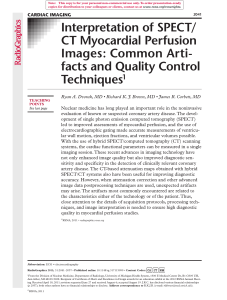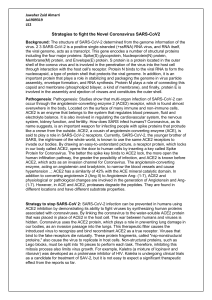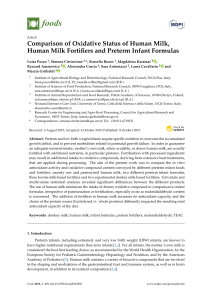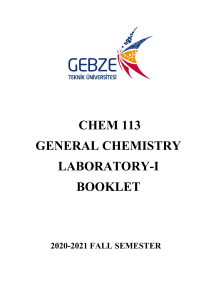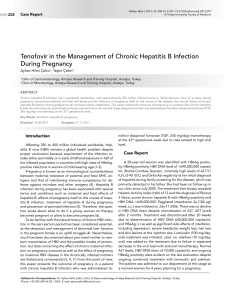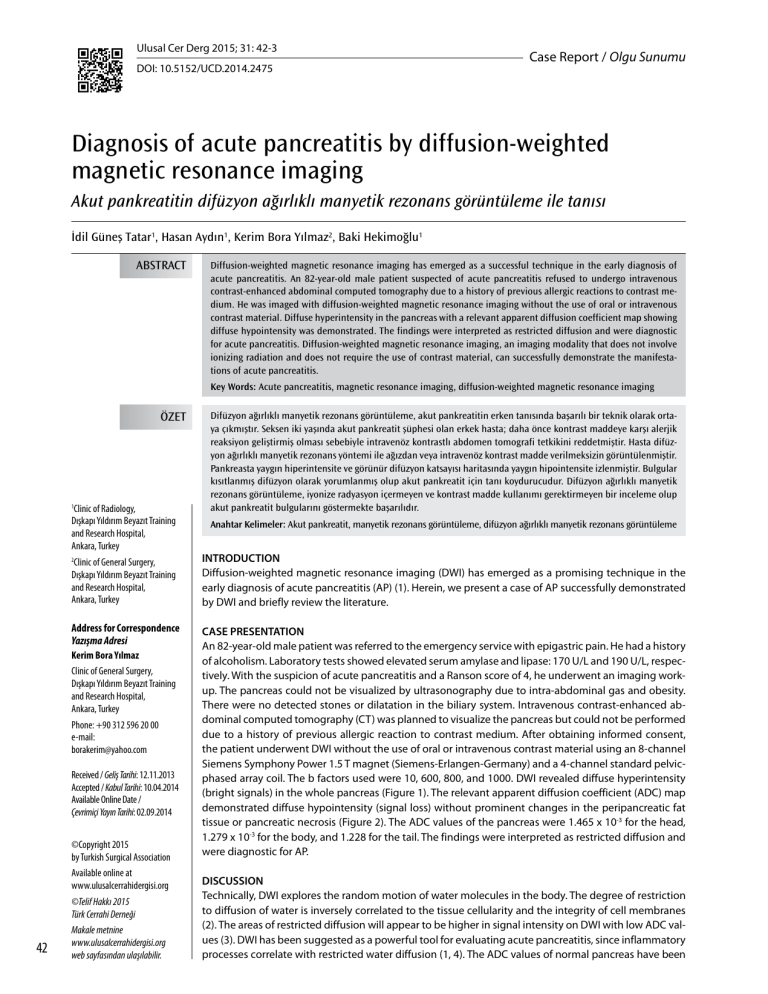
Ulusal Cer Derg 2015; 31: 42-3
DOI: 10.5152/UCD.2014.2475
Case Report / Olgu Sunumu
Diagnosis of acute pancreatitis by diffusion-weighted
magnetic resonance imaging
Akut pankreatitin difüzyon ağırlıklı manyetik rezonans görüntüleme ile tanısı
İdil Güneş Tatar1, Hasan Aydın1, Kerim Bora Yılmaz2, Baki Hekimoğlu1
ABSTRACT
Diffusion-weighted magnetic resonance imaging has emerged as a successful technique in the early diagnosis of
acute pancreatitis. An 82-year-old male patient suspected of acute pancreatitis refused to undergo intravenous
contrast-enhanced abdominal computed tomography due to a history of previous allergic reactions to contrast medium. He was imaged with diffusion-weighted magnetic resonance imaging without the use of oral or intravenous
contrast material. Diffuse hyperintensity in the pancreas with a relevant apparent diffusion coefficient map showing
diffuse hypointensity was demonstrated. The findings were interpreted as restricted diffusion and were diagnostic
for acute pancreatitis. Diffusion-weighted magnetic resonance imaging, an imaging modality that does not involve
ionizing radiation and does not require the use of contrast material, can successfully demonstrate the manifestations of acute pancreatitis.
Key Words: Acute pancreatitis, magnetic resonance imaging, diffusion-weighted magnetic resonance imaging
ÖZET
Clinic of Radiology,
Dışkapı Yıldırım Beyazıt Training
and Research Hospital,
Ankara, Turkey
1
Anahtar Kelimeler: Akut pankreatit, manyetik rezonans görüntüleme, difüzyon ağırlıklı manyetik rezonans görüntüleme
Clinic of General Surgery,
Dışkapı Yıldırım Beyazıt Training
and Research Hospital,
Ankara, Turkey
INTRODUCTION
Diffusion-weighted magnetic resonance imaging (DWI) has emerged as a promising technique in the
early diagnosis of acute pancreatitis (AP) (1). Herein, we present a case of AP successfully demonstrated
by DWI and briefly review the literature.
Address for Correspondence
Yazışma Adresi
CASE PRESENTATION
An 82-year-old male patient was referred to the emergency service with epigastric pain. He had a history
of alcoholism. Laboratory tests showed elevated serum amylase and lipase: 170 U/L and 190 U/L, respectively. With the suspicion of acute pancreatitis and a Ranson score of 4, he underwent an imaging workup. The pancreas could not be visualized by ultrasonography due to intra-abdominal gas and obesity.
There were no detected stones or dilatation in the biliary system. Intravenous contrast-enhanced abdominal computed tomography (CT) was planned to visualize the pancreas but could not be performed
due to a history of previous allergic reaction to contrast medium. After obtaining informed consent,
the patient underwent DWI without the use of oral or intravenous contrast material using an 8-channel
Siemens Symphony Power 1.5 T magnet (Siemens-Erlangen-Germany) and a 4-channel standard pelvicphased array coil. The b factors used were 10, 600, 800, and 1000. DWI revealed diffuse hyperintensity
(bright signals) in the whole pancreas (Figure 1). The relevant apparent diffusion coefficient (ADC) map
demonstrated diffuse hypointensity (signal loss) without prominent changes in the peripancreatic fat
tissue or pancreatic necrosis (Figure 2). The ADC values of the pancreas were 1.465 x 10-3 for the head,
1.279 x 10-3 for the body, and 1.228 for the tail. The findings were interpreted as restricted diffusion and
were diagnostic for AP.
2
Kerim Bora Yılmaz
Clinic of General Surgery,
Dışkapı Yıldırım Beyazıt Training
and Research Hospital,
Ankara, Turkey
Phone: +90 312 596 20 00
e-mail:
[email protected]
Received / Geliş Tarihi: 12.11.2013
Accepted / Kabul Tarihi: 10.04.2014
Available Online Date /
Çevrimiçi Yayın Tarihi: 02.09.2014
©Copyright 2015
by Turkish Surgical Association
Available online at
www.ulusalcerrahidergisi.org
©Telif Hakkı 2015
Türk Cerrahi Derneği
42
Difüzyon ağırlıklı manyetik rezonans görüntüleme, akut pankreatitin erken tanısında başarılı bir teknik olarak ortaya çıkmıştır. Seksen iki yaşında akut pankreatit şüphesi olan erkek hasta; daha önce kontrast maddeye karşı alerjik
reaksiyon geliştirmiş olması sebebiyle intravenöz kontrastlı abdomen tomografi tetkikini reddetmiştir. Hasta difüzyon ağırlıklı manyetik rezonans yöntemi ile ağızdan veya intravenöz kontrast madde verilmeksizin görüntülenmiştir.
Pankreasta yaygın hiperintensite ve görünür difüzyon katsayısı haritasında yaygın hipointensite izlenmiştir. Bulgular
kısıtlanmış difüzyon olarak yorumlanmış olup akut pankreatit için tanı koydurucudur. Difüzyon ağırlıklı manyetik
rezonans görüntüleme, iyonize radyasyon içermeyen ve kontrast madde kullanımı gerektirmeyen bir inceleme olup
akut pankreatit bulgularını göstermekte başarılıdır.
Makale metnine
www.ulusalcerrahidergisi.org
web sayfasından ulaşılabilir.
DISCUSSION
Technically, DWI explores the random motion of water molecules in the body. The degree of restriction
to diffusion of water is inversely correlated to the tissue cellularity and the integrity of cell membranes
(2). The areas of restricted diffusion will appear to be higher in signal intensity on DWI with low ADC values (3). DWI has been suggested as a powerful tool for evaluating acute pancreatitis, since inflammatory
processes correlate with restricted water diffusion (1, 4). The ADC values of normal pancreas have been
Ulusal Cer Derg 2015; 31: 42-3
Informed Consent: Written informed consent was obtained from patient who participated in this case.
Peer-review: Externally peer-reviewed.
Author Contributions: Concept - İ.G.T.; Design - H.A., İ.G.T.; Supervision
- B.H.; Funding - H.A., İ.G.T.; Materials - K.B.Y., B.H.; Data Collection and/
or Processing - K.B.Y., H.A.; Analysis and/or Interpretation - İ.G.T., H.A.; Literature Review - B.H., İ.G.T.; Writer - İ.G.T., H.A.; Critical Review - B.H., K.B.Y.
Conflict of Interest: No conflict of interest was declared by the authors.
Figure 1. Diffusion-weighted imaging shows diffuse
hyperintensity in pancreas (stars) correlated with restricted
diffusion
Financial Disclosure: The authors declared that this study has received no financial support.
Hasta Onamı: Yazılı hasta onamı bu olguya katılan hastadan alınmıştır.
Hakem değerlendirmesi: Dış bağımsız.
Yazar Katkıları: Fikir - İ.G.T.; Tasarım - H.A., İ.G.T.; Denetleme - B.H.; Kaynaklar - H.A., İ.G.T.; Malzemeler - K.B.Y., B.H.; Veri toplanması ve/veya işlemesi
- K.B.Y., H.A.; Analiz ve/veya yorum - İ.G.T., H.A.; Literatür taraması - B.H.,
İ.G.T.; Yazıyı yazan - İ.G.T., H.A.; Eleştirel İnceleme - B.H., K.B.Y.
Çıkar Çatışması: Yazarlar çıkar çatışması bildirmemişlerdir.
Finansal Destek: Yazarlar bu çalışma için finansal destek almadıklarını
beyan etmişlerdir.
REFERENCES
Figure 2. Apparent diffusion coefficient map shows diffuse
hypointensity in pancreas (stars) compatible with restricted
diffusion
investigated in several studies. According to the literature, the
mean ADC values derived from the head, body, and tail range
between 1.02 x 10-3 and 1.94 x 10-3 mm2//s. Head and body reveal
slightly higher ADC values when compared with the tail (5, 6).
The greatest advantage of DWI in diagnosing AP is the fact
that no contrast medium is needed. CT imaging with the administration of intravenous contrast medium is harmful in patients with renal failure in severe AP, since intravenous use of
contrast material is reported to aggravate AP (7). Besides, CT
is preferably obtained between the fourth and tenth day after
the disease onset, since it is classically said that a very early CT
is not very helpful (8). In pregnant patients, a diagnostic challenge also occurs, since the ionizing radiation acquired during
the CT examination is potentially harmful for the fetus (9). At
this point, magnetic resonance imaging can be an option in
the diagnosis of AP, but it still needs to be further investigated,
since some concerns have been raised about thermal injury to
the fetus in the first trimester (10, 11). DWI is also an excellent
imaging alternative for patients with a history of allergy to intravenous contrast medium, such as in our case.
CONCLUSION
It should be kept in mind that DWI, an imaging modality that
does not involve ionizing radiation, can successfully display
the manifestations of acute pancreatitis in an earlier phase
compared to other imaging modalities.
1. Thomas S, Kayhan A, Lakadamyali H, Oto A. Diffusion MRI of
acute pancreatitis and comparison with normal individuals using
ADC values. Emerg Radiol 2012; 19: 5-9. [CrossRef]
2. Guo Y, Cai YQ, Cai ZL, Gao YG, An NY, Ma L, et al. Differentiation of clinically benign and malignant breast lesions using diffusion-weighted
imaging. J Magn Reson Imaging 2002; 16: 172-178. [CrossRef]
3. Higano S, Yun X, Kumabe T, Watanabe M, Muqikura S, Umetsu A,
et al. Malignant astrocytic tumors: clinical importance of apparent diffusion coefficient in prediction of grade and prognosis.
Radiology 2006; 24: 839-846. [CrossRef]
4. Shinya S, Sasaki T, Nakagawa Y, Guiquing Z, Yamamoto F, Yamashita Y. Acute pancreatitis successfully diagnosed by diffusionweighted imaging: A case report. World J Gastroenterol 2008; 14:
5478-5480. [CrossRef]
5. Schmidt GP, Kramer H, Reiser MF, Glaser C. Whole-body magnetic
resonance imaging and positron emission tomography-computed
tomography in oncology. Top Magn Reson Imaging 2007; 18: 193-202.
[CrossRef]
6. Yoshikawa T, Kawamitsu H, Mitchell DG, Ohno Y, Ku Y, Seo Y. ADC
measurement of abdominal organs and lesions using parallel imaging technique. AJR 2006; 187: 1521-1530. [CrossRef]
7. Carmona-Sanchez R, Uscanga L, Bezaury-Rivas P, Robles-Diaz G,
Suazo-Barahona J, Vargas-Vorackova F. Potential harmful effect of iodinated intravenous contrast medium on the clinical course of mild
acute pancreatitis. Arch Surg 2000; 135: 1280-1284. [CrossRef]
8. Cruz-Santamaría DM, Taxonera C, Giner M. Update on pathogenesis and clinical management of acute pancreatitis. World J Gastrointest Pathophysiol 2012; 3: 60-70. [CrossRef]
9. Pitchumoni C, Yegneswaran B. Acute pancreatitis in pregnancy.
World J Gastroenterol 2009; 15: 5641-5646. [CrossRef]
10. Levine D, Zuo C, Faro CB, Chen Q. Potential heating effect in the
gravid uterus during MR HASTE imaging. J Magn Reson Imaging
2001; 13: 856-861. [CrossRef]
11. Leyendecker JR, Gorengaut V, Brown JJ. MR imaging of maternal diseases of the abdomen and pelvis during pregnancy and the immediate
postpartum period. Radiographics 2004; 24: 1301-1316. [CrossRef]
43

